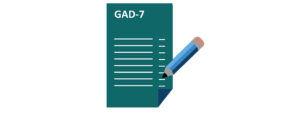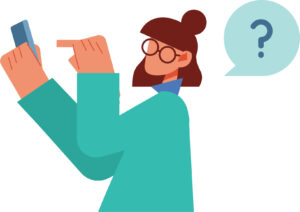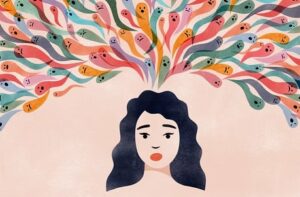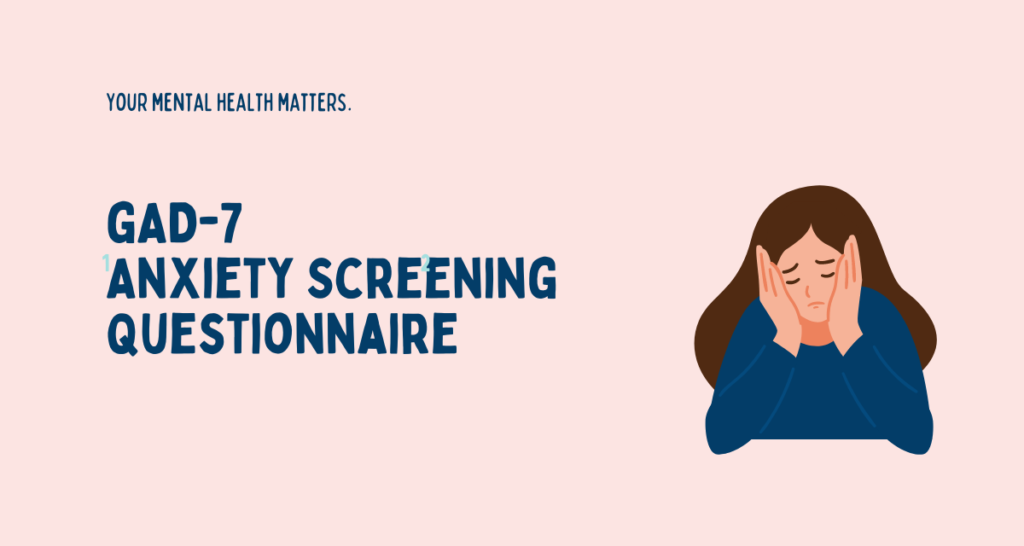The GAD-7 scale is a popular tool for assessing anxiety. It is used by mental health professionals all over the world to measure the severity of anxiety symptoms in their patients. In this comprehensive guide, we will discuss everything you need to know about the GAD-7 scale. We will cover what it is, how it works, and how to interpret the results. We will also provide examples of how to use the scale in clinical practice. If you are looking for a reliable way to assess anxiety symptoms, the GAD-7 scale is a great option!
Contents
- 1 What Is The GAD-7 Scale?
- 2 How Does The GAD-7 Scale Work?
- 3 Items In The GAD-7 Scale
- 4 Scoring The GAD-7 Scale
- 5 How To Interpret The Results Of The GAD-7 Scale?
- 6 How To Use The GAD-7 Scale In Clinical Practice?
- 7 Who Can Use The GAD-7 Scale For Diagnosis?
- 8 When Should The GAD-7Scale Be Used?
- 9 Treatment For Anxiety
- 10 Conclusion
What Is The GAD-7 Scale?

The GAD-seven scale is a self-report measure of anxiety. It was developed by Stanley Rachman and colleagues in 1971 and has since been widely used in research and clinical practice. The scale consists of seven items, each of which measures a different aspect of anxiety symptoms. These items are worry, tension, restlessness, muscle pain, fatigue, difficulty concentrating, and irritability. Each item is rated on a four-point scale from 0 (not at all) to
The GAD-seven scale is a popular tool for assessing anxiety because it is quick and easy to administer. It can be completed in just a few minutes, and the results can give you valuable insights into your patients’ level of anxiety. The scale is also highly reliable, which means that it produces consistent results.
How Does The GAD-7 Scale Work?
The scale can be administered in paper-and-pencil format or online. It takes most people just a few minutes to complete.
To administer the scale, simply ask your patients to rate each of the seven items on a four-point scale from 0-4 being minimal Anxiety, 5-9 indicating mild anxiety. The score of 10-14 implying moderate anxiety. A Score greater than 15 is a sign of Severe Anxiety.
The GAD-seven scale works by measuring the severity of anxiety symptoms. To do this, patients are asked to rate how much they have been bothered by each of the seven items over the past two weeks. The total score can range from 0 to 21, with higher scores indicating more severe anxiety symptoms.
Patients are typically considered to have mild anxiety if their score is between 0 and 13, moderate anxiety if their score is between 14 and 20, and severe anxiety if their score is 21 or above. However, it is important to note that these cutoff points are just guidelines and should not be used to make diagnoses. Diagnoses should always be made by a qualified mental health professional.
Items In The GAD-7 Scale
The seven items in the GAD-seven scale measure different aspects of anxiety. These items are:
Worry: This item measures how much patients have been bothered by worry over the past two weeks.
Tension: This item measures how much patients have felt tense or keyed up over the past two weeks. It includes symptoms such as feeling jumpy or on edge.
Restlessness: This item measures how much patients have felt restless or on edge over the past two weeks. It includes feeling unable to relax, feeling fidgety, or being so restless that it is hard to sit still.
Muscle pain: This item measures how much muscle pain or achiness patients have experienced over the past two weeks. This can include feeling tense or tightness in the muscles, as well as actual pain.
Fatigue: This item measures how much fatigue or tiredness patients have experienced over the past two weeks. This can include feeling physically or mentally exhausted, feeling sleepy during the day, or having a hard time concentrating because of fatigue.
Difficulty concentrating: This item measures how much patients have felt like their anxiety has interfered with their ability to concentrate on tasks over the past two weeks. It includes feeling like your mind is going blank, being easily distracted, or having difficulty focusing on work or other activities.
Irritability: This item measures how much irritability or impatience patients have felt over the past two weeks. It includes feeling short-tempered, touchy, or cranky.
These seven items are the primary symptoms of any type of anxiety disorder. By measuring the severity of these symptoms, the GAD-seven scale can also give you a good idea of how much anxiety a patient is experiencing.
Scoring The GAD-7 Scale

The GAD-seven scale is scored by adding up the ratings for each of the seven items. The total score can range from 0 to 21, with higher scores indicating more severe anxiety symptoms.
Patients are typically considered to have mild anxiety if their score is between 0 and 13, moderate anxiety if their score is between 14 and 20, and severe anxiety if their score is 21 or above. However, it is important to note that these cutoff points are just guidelines and should not be used to make diagnoses. Diagnoses should always be made by a qualified mental health professional.
How To Interpret The Results Of The GAD-7 Scale?
The results of the GAD-seven scale can give you valuable insights into your patients’ level of anxiety. Patients with mild anxiety may benefit from lifestyle changes or relaxation techniques. Patients with moderate to severe anxiety may need more intensive treatment, such as cognitive-behavioral therapy or medication.
This scale should not be used to diagnose anxiety disorders. Rather, it should be used as a way to measure the severity of anxiety symptoms and track changes over time. If you are concerned about your own anxiety levels, you can take the GAD-seven scale here. Remember, if you are experiencing significant distress or impairment, it is important to seek help from a qualified mental health professional.
How To Use The GAD-7 Scale In Clinical Practice?

Now let’s take a further look at an example of how the GAD-seven scale can be used in clinical practice.
Suppose you are a mental health professional who is seeing a new patient for an initial evaluation. During the session, you administer the GAD-seven scale to the patient. The patient’s score is 16, which falls into the moderate range. This information can give you valuable insights into the severity of the patient’s anxiety symptoms.
You can use this information to develop a treatment plan that is tailored to the individual’s needs. For example, you may decide to provide more intensive therapy for a patient with moderate anxiety than you would for a patient with mild anxiety. The GAD-seven scale can also be used to track changes in anxiety symptoms over time. For example, if a patient’s score decreases from 16 to 14 after several weeks of treatment, this would be considered a positive change.
Who Can Use The GAD-7 Scale For Diagnosis?
The GAD-seven scale can be used by any mental health professional, such as a psychiatrist, psychologist, or licensed counselor. It is important to note that the GAD-seven scale should not be used to make diagnoses. Rather, it should be used as a way to measure the severity of anxiety symptoms and track changes over time. If you are concerned about your own anxiety levels, you can take the GAD-seven scale here. Remember, if you are experiencing significant distress or impairment, it is important to seek help from a qualified mental health professional.
When Should The GAD-7Scale Be Used?
The GAD-seven scale can be administered at any point during treatment. However, it is often given at the beginning of treatment to get a baseline measure of anxiety symptoms. It can then be given periodically throughout treatment to track changes in anxiety levels.
The GAD-seven scale is a valuable tool for assessing anxiety symptoms. It can be used to track changes in anxiety over time and also to tailor treatment plans to the individual’s needs. If you are concerned about your own anxiety levels, you can take the GAD-seven scale here. Remember, if you are experiencing significant distress or impairment, it is important to seek help from a qualified mental health professional.
Treatment For Anxiety

Anxiety is a debilitating condition, but there is hope. With treatment, many people are able to manage their anxiety and live happy, productive lives. If you are struggling with anxiety, there are many treatment options available.
Medication
Medication can be an effective treatment for anxiety. There are many different types of medication that help to treat anxiety disorders. Most commonly prescribed anxiety medications include:
- Selective serotonin reuptake inhibitors (SSRIs)
- Serotonin and norepinephrine reuptake inhibitors (SNRIs)
- Benzodiazepines
- Beta-blockers
- Tricyclic antidepressants
- Azospirodecanediones
- Antipsychotic medications
It is important to keep in contact with your doctor as they can monitor the effectiveness as well as the side effects of medication on your mental health.
Therapy
Cognitive-behavioral therapy: Cognitive-behavioral therapy is a type of therapy that helps people change their thinking patterns and behaviors. CBT is an effective treatment for anxiety.
Exposure therapy: Exposure therapy is a type of cognitive-behavioral therapy that involves gradually exposing yourself to the things you fear. This involves gradually increasing your exposure to the things you fear until you no longer feel anxious.
Support groups: Support groups provide a way for people to connect with others who are dealing with similar issues. This can be a valuable way to share information and support each other.
Psychotherapy: Psychotherapy is a type of therapy that involves talking to a therapist about your thoughts and feelings. It helps anxiety by teaching you how to better manage your thoughts and emotions.
Self Help Tips
There are also lifestyle changes you can make to help reduce anxiety. These include:
- Exercise: Exercise can help reduce stress and improve your mood. It also helps to improve your overall health. Physical activity also releases endorphins, which are the stress-relief hormones, that help in managing anxiety.
- Relaxation techniques: Relaxation techniques, such as yoga or meditation, can help you calm your mind and body.
- Practice self-care: Self-care is important for managing stress. This includes activities such as getting enough sleep, eating healthy foods, and taking time for yourself.
- Limit alcohol and caffeine: Alcohol and caffeine can make anxiety worse. If you are struggling with anxiety, it is important to limit your intake of these substances.
- Talk to someone you trust: Talking to someone you trust about your anxiety can help you feel better. This person can further provide support and understanding. This can be a family member, friend, colleague therapist, or even your pet.
- Healthy diet: Eating a healthy diet can help you feel better and reduce stress. Include plenty of fruits, vegetables, and whole grains in your diet.
- Journal: Keeping a journal can help you identify your anxiety triggers and find ways to cope with them.
- Get enough sleep: Getting enough sleep is important for overall health and well-being. Make sure to get at least seven to eight hours of sleep each night.
Anxiety can be a debilitating condition, but there is hope. With treatment, many people are able to manage their anxiety and live happy, productive lives. If you are struggling with anxiety, there are many treatment options available. Remember, if you are experiencing significant distress or impairment, it is important to seek help from a qualified mental health professional.
Conclusion
The GAD-seven scale is a valuable tool for assessing anxiety symptoms. When used correctly, it can provide valuable insights into the severity of anxiety and help you create an effective treatment plan. If you are concerned about your own anxiety levels, or those of someone you know, please contact a mental health professional for further assessment.
For more information, please contact MantraCare. Anxiety is a common mental health condition characterized by persistent feelings of worry, fear, and apprehension. If you have any queries regarding Online Anxiety Counseling experienced therapists at MantraCare can help: Book a trial Anxiety therapy session


